Analysis of Operations and Project Management at Sainsbury's Report
VerifiedAdded on 2022/12/29
|19
|4941
|1
Report
AI Summary
This report provides a comprehensive analysis of Sainsbury's operations and project management practices. It begins with an introduction to Sainsbury's and a distinction between operations and operations management. The first part of the report delves into the application of operations management principles, such as variance, organization, and change, within the organizational context, critically reviewing their implementation. It further examines continuous improvement plans, focusing on their philosophical structure and lean principles, including value definition, value stream mapping, flow creation, pull establishment, and the pursuit of perfection. The report then transitions to the product life cycle (PLC), applying its different stages and supporting documentation to Sainsbury's operations. It concludes with a review and critique of strategies aimed at increasing the effectiveness of the PLC, providing a well-rounded view of Sainsbury's approach to operations and project management.
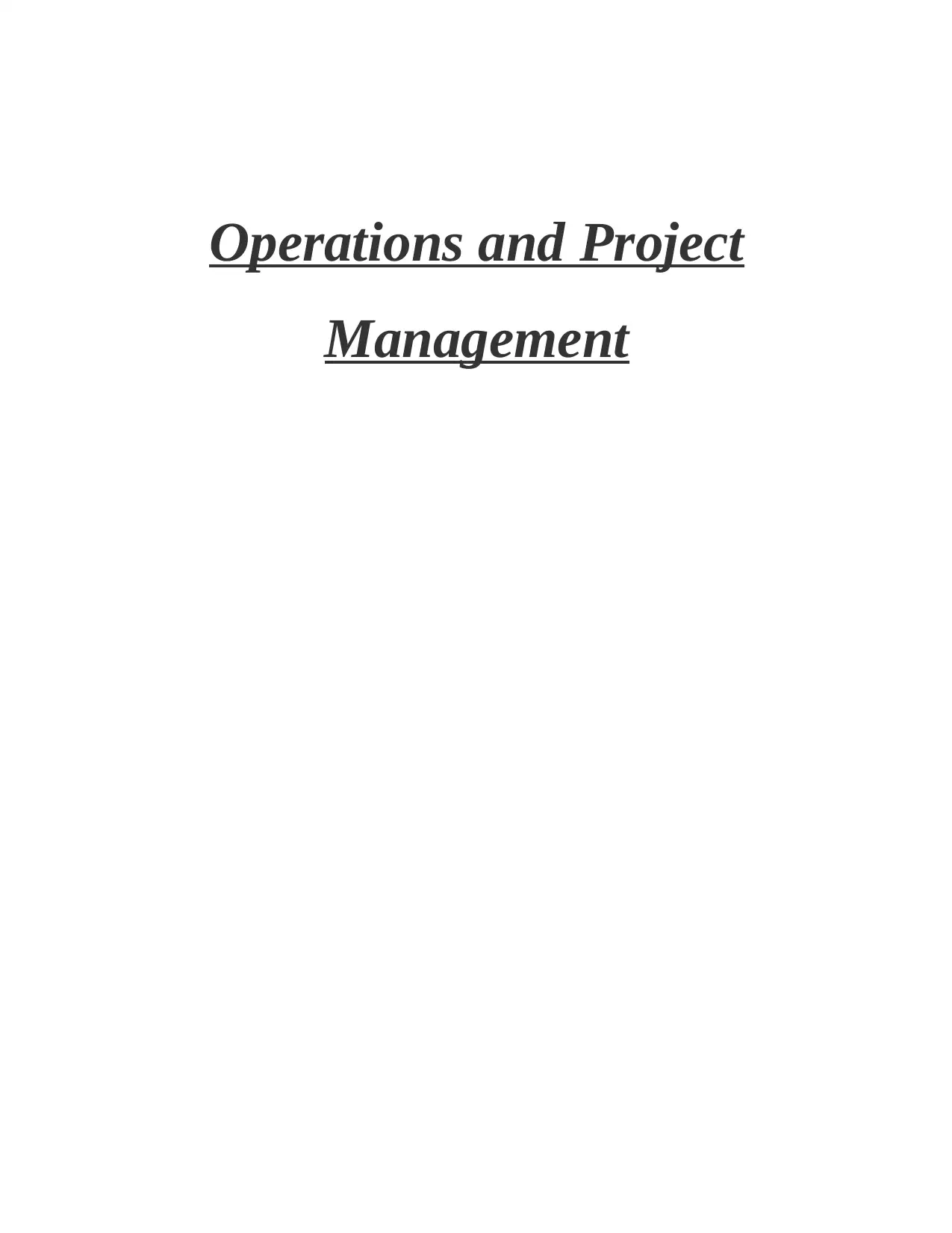
Operations and Project
Management
Management
Paraphrase This Document
Need a fresh take? Get an instant paraphrase of this document with our AI Paraphraser
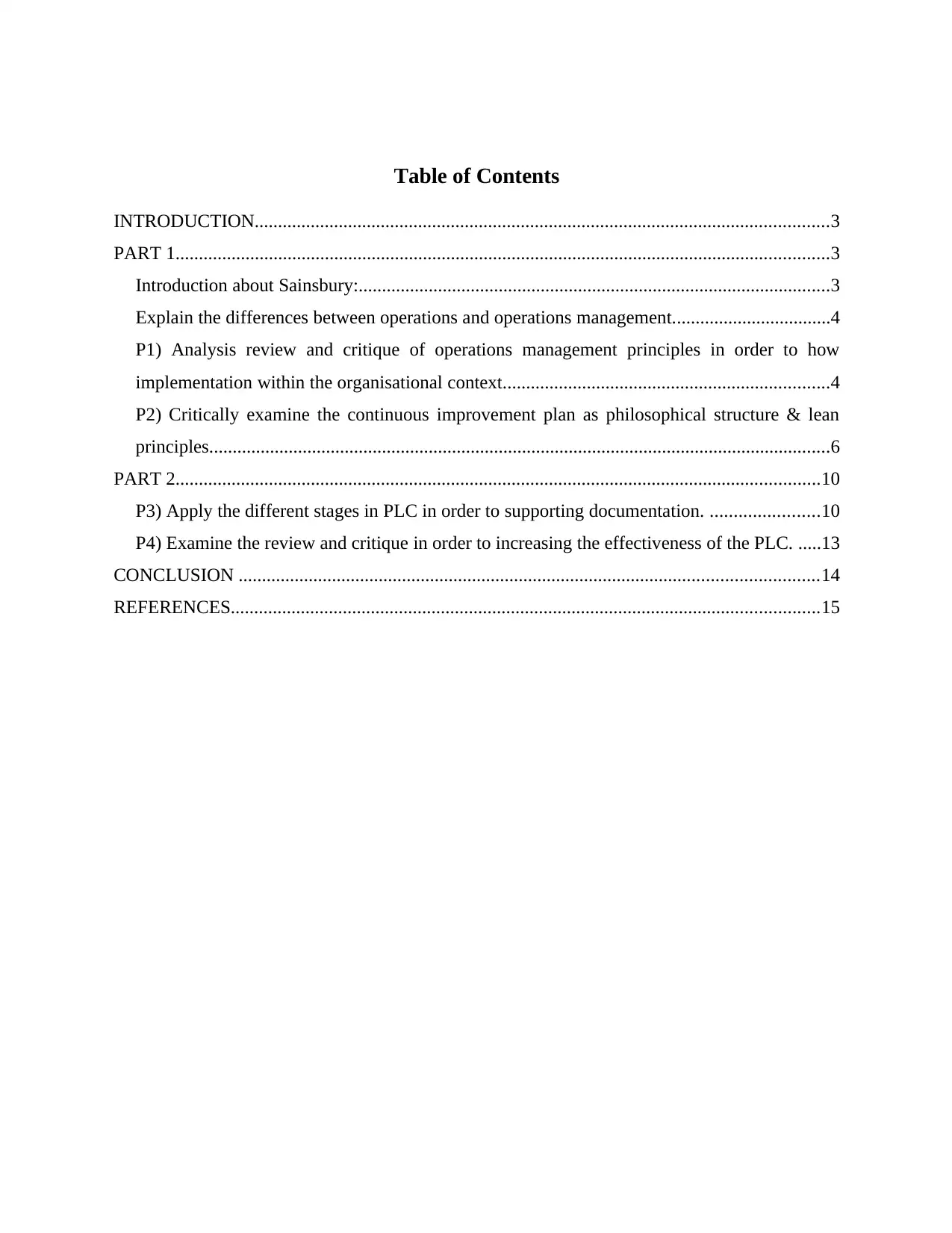
Table of Contents
INTRODUCTION...........................................................................................................................3
PART 1............................................................................................................................................3
Introduction about Sainsbury:.....................................................................................................3
Explain the differences between operations and operations management..................................4
P1) Analysis review and critique of operations management principles in order to how
implementation within the organisational context......................................................................4
P2) Critically examine the continuous improvement plan as philosophical structure & lean
principles.....................................................................................................................................6
PART 2..........................................................................................................................................10
P3) Apply the different stages in PLC in order to supporting documentation. .......................10
P4) Examine the review and critique in order to increasing the effectiveness of the PLC. .....13
CONCLUSION ............................................................................................................................14
REFERENCES..............................................................................................................................15
INTRODUCTION...........................................................................................................................3
PART 1............................................................................................................................................3
Introduction about Sainsbury:.....................................................................................................3
Explain the differences between operations and operations management..................................4
P1) Analysis review and critique of operations management principles in order to how
implementation within the organisational context......................................................................4
P2) Critically examine the continuous improvement plan as philosophical structure & lean
principles.....................................................................................................................................6
PART 2..........................................................................................................................................10
P3) Apply the different stages in PLC in order to supporting documentation. .......................10
P4) Examine the review and critique in order to increasing the effectiveness of the PLC. .....13
CONCLUSION ............................................................................................................................14
REFERENCES..............................................................................................................................15
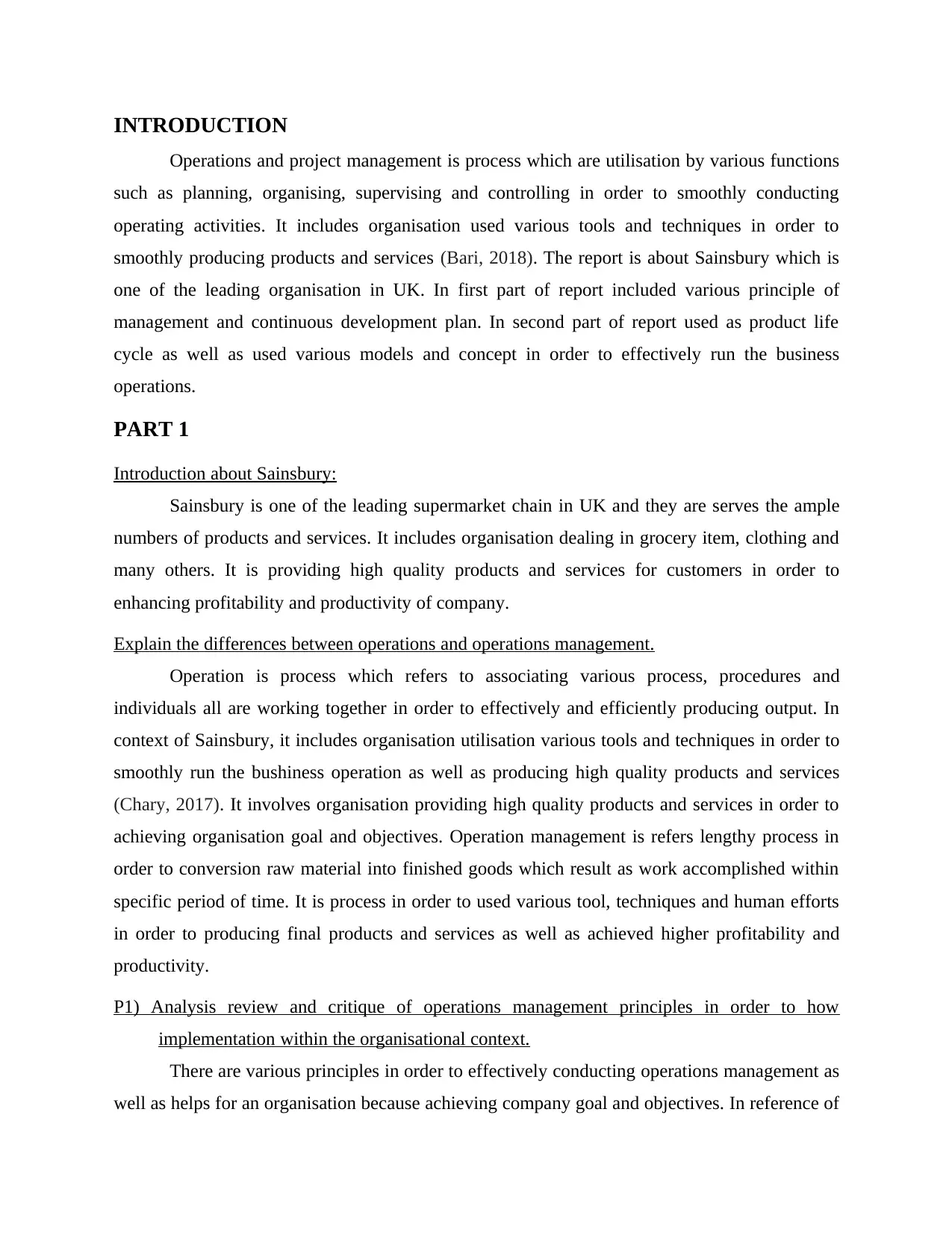
INTRODUCTION
Operations and project management is process which are utilisation by various functions
such as planning, organising, supervising and controlling in order to smoothly conducting
operating activities. It includes organisation used various tools and techniques in order to
smoothly producing products and services (Bari, 2018). The report is about Sainsbury which is
one of the leading organisation in UK. In first part of report included various principle of
management and continuous development plan. In second part of report used as product life
cycle as well as used various models and concept in order to effectively run the business
operations.
PART 1
Introduction about Sainsbury:
Sainsbury is one of the leading supermarket chain in UK and they are serves the ample
numbers of products and services. It includes organisation dealing in grocery item, clothing and
many others. It is providing high quality products and services for customers in order to
enhancing profitability and productivity of company.
Explain the differences between operations and operations management.
Operation is process which refers to associating various process, procedures and
individuals all are working together in order to effectively and efficiently producing output. In
context of Sainsbury, it includes organisation utilisation various tools and techniques in order to
smoothly run the bushiness operation as well as producing high quality products and services
(Chary, 2017). It involves organisation providing high quality products and services in order to
achieving organisation goal and objectives. Operation management is refers lengthy process in
order to conversion raw material into finished goods which result as work accomplished within
specific period of time. It is process in order to used various tool, techniques and human efforts
in order to producing final products and services as well as achieved higher profitability and
productivity.
P1) Analysis review and critique of operations management principles in order to how
implementation within the organisational context.
There are various principles in order to effectively conducting operations management as
well as helps for an organisation because achieving company goal and objectives. In reference of
Operations and project management is process which are utilisation by various functions
such as planning, organising, supervising and controlling in order to smoothly conducting
operating activities. It includes organisation used various tools and techniques in order to
smoothly producing products and services (Bari, 2018). The report is about Sainsbury which is
one of the leading organisation in UK. In first part of report included various principle of
management and continuous development plan. In second part of report used as product life
cycle as well as used various models and concept in order to effectively run the business
operations.
PART 1
Introduction about Sainsbury:
Sainsbury is one of the leading supermarket chain in UK and they are serves the ample
numbers of products and services. It includes organisation dealing in grocery item, clothing and
many others. It is providing high quality products and services for customers in order to
enhancing profitability and productivity of company.
Explain the differences between operations and operations management.
Operation is process which refers to associating various process, procedures and
individuals all are working together in order to effectively and efficiently producing output. In
context of Sainsbury, it includes organisation utilisation various tools and techniques in order to
smoothly run the bushiness operation as well as producing high quality products and services
(Chary, 2017). It involves organisation providing high quality products and services in order to
achieving organisation goal and objectives. Operation management is refers lengthy process in
order to conversion raw material into finished goods which result as work accomplished within
specific period of time. It is process in order to used various tool, techniques and human efforts
in order to producing final products and services as well as achieved higher profitability and
productivity.
P1) Analysis review and critique of operations management principles in order to how
implementation within the organisational context.
There are various principles in order to effectively conducting operations management as
well as helps for an organisation because achieving company goal and objectives. In reference of
⊘ This is a preview!⊘
Do you want full access?
Subscribe today to unlock all pages.

Trusted by 1+ million students worldwide
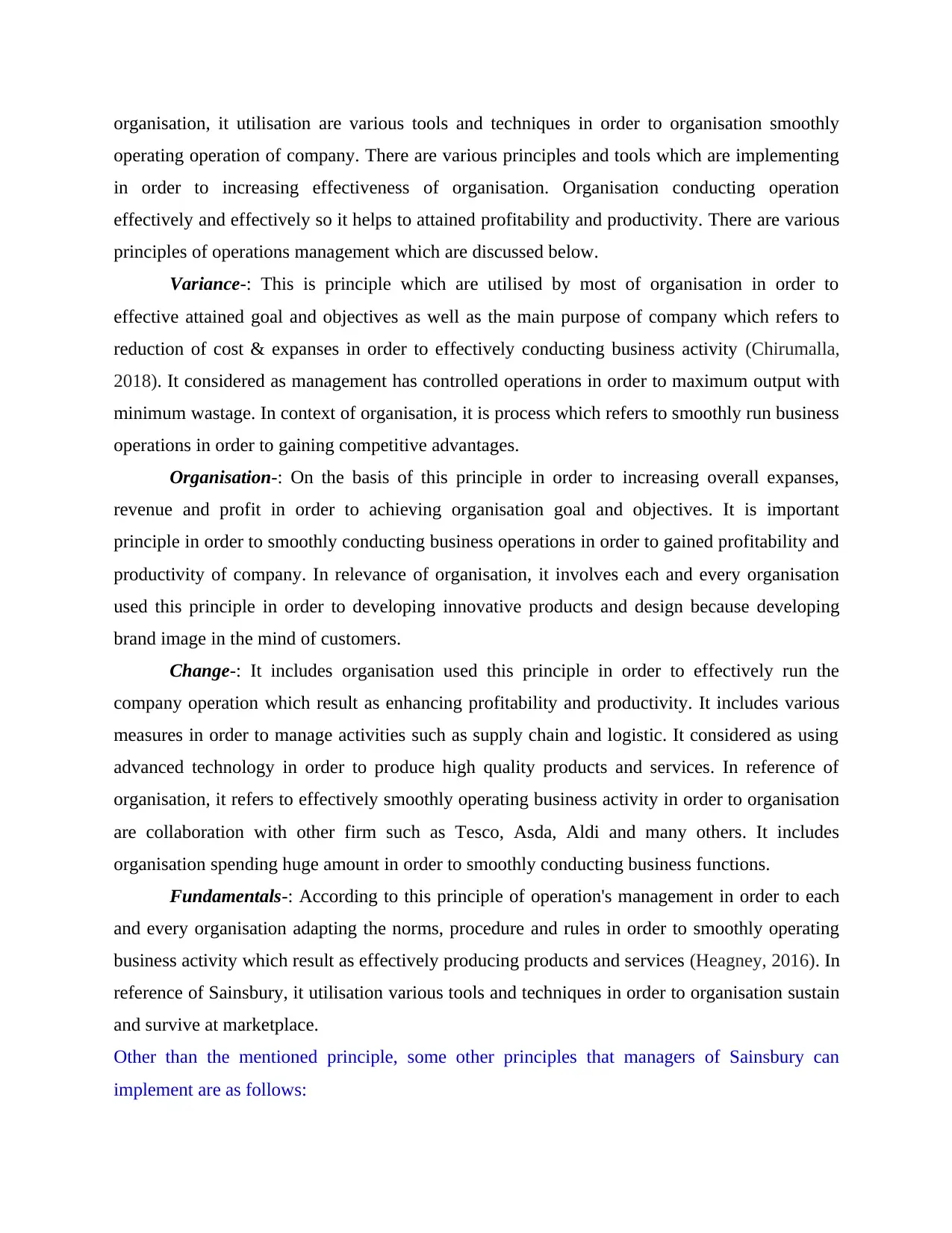
organisation, it utilisation are various tools and techniques in order to organisation smoothly
operating operation of company. There are various principles and tools which are implementing
in order to increasing effectiveness of organisation. Organisation conducting operation
effectively and effectively so it helps to attained profitability and productivity. There are various
principles of operations management which are discussed below.
Variance-: This is principle which are utilised by most of organisation in order to
effective attained goal and objectives as well as the main purpose of company which refers to
reduction of cost & expanses in order to effectively conducting business activity (Chirumalla,
2018). It considered as management has controlled operations in order to maximum output with
minimum wastage. In context of organisation, it is process which refers to smoothly run business
operations in order to gaining competitive advantages.
Organisation-: On the basis of this principle in order to increasing overall expanses,
revenue and profit in order to achieving organisation goal and objectives. It is important
principle in order to smoothly conducting business operations in order to gained profitability and
productivity of company. In relevance of organisation, it involves each and every organisation
used this principle in order to developing innovative products and design because developing
brand image in the mind of customers.
Change-: It includes organisation used this principle in order to effectively run the
company operation which result as enhancing profitability and productivity. It includes various
measures in order to manage activities such as supply chain and logistic. It considered as using
advanced technology in order to produce high quality products and services. In reference of
organisation, it refers to effectively smoothly operating business activity in order to organisation
are collaboration with other firm such as Tesco, Asda, Aldi and many others. It includes
organisation spending huge amount in order to smoothly conducting business functions.
Fundamentals-: According to this principle of operation's management in order to each
and every organisation adapting the norms, procedure and rules in order to smoothly operating
business activity which result as effectively producing products and services (Heagney, 2016). In
reference of Sainsbury, it utilisation various tools and techniques in order to organisation sustain
and survive at marketplace.
Other than the mentioned principle, some other principles that managers of Sainsbury can
implement are as follows:
operating operation of company. There are various principles and tools which are implementing
in order to increasing effectiveness of organisation. Organisation conducting operation
effectively and effectively so it helps to attained profitability and productivity. There are various
principles of operations management which are discussed below.
Variance-: This is principle which are utilised by most of organisation in order to
effective attained goal and objectives as well as the main purpose of company which refers to
reduction of cost & expanses in order to effectively conducting business activity (Chirumalla,
2018). It considered as management has controlled operations in order to maximum output with
minimum wastage. In context of organisation, it is process which refers to smoothly run business
operations in order to gaining competitive advantages.
Organisation-: On the basis of this principle in order to increasing overall expanses,
revenue and profit in order to achieving organisation goal and objectives. It is important
principle in order to smoothly conducting business operations in order to gained profitability and
productivity of company. In relevance of organisation, it involves each and every organisation
used this principle in order to developing innovative products and design because developing
brand image in the mind of customers.
Change-: It includes organisation used this principle in order to effectively run the
company operation which result as enhancing profitability and productivity. It includes various
measures in order to manage activities such as supply chain and logistic. It considered as using
advanced technology in order to produce high quality products and services. In reference of
organisation, it refers to effectively smoothly operating business activity in order to organisation
are collaboration with other firm such as Tesco, Asda, Aldi and many others. It includes
organisation spending huge amount in order to smoothly conducting business functions.
Fundamentals-: According to this principle of operation's management in order to each
and every organisation adapting the norms, procedure and rules in order to smoothly operating
business activity which result as effectively producing products and services (Heagney, 2016). In
reference of Sainsbury, it utilisation various tools and techniques in order to organisation sustain
and survive at marketplace.
Other than the mentioned principle, some other principles that managers of Sainsbury can
implement are as follows:
Paraphrase This Document
Need a fresh take? Get an instant paraphrase of this document with our AI Paraphraser
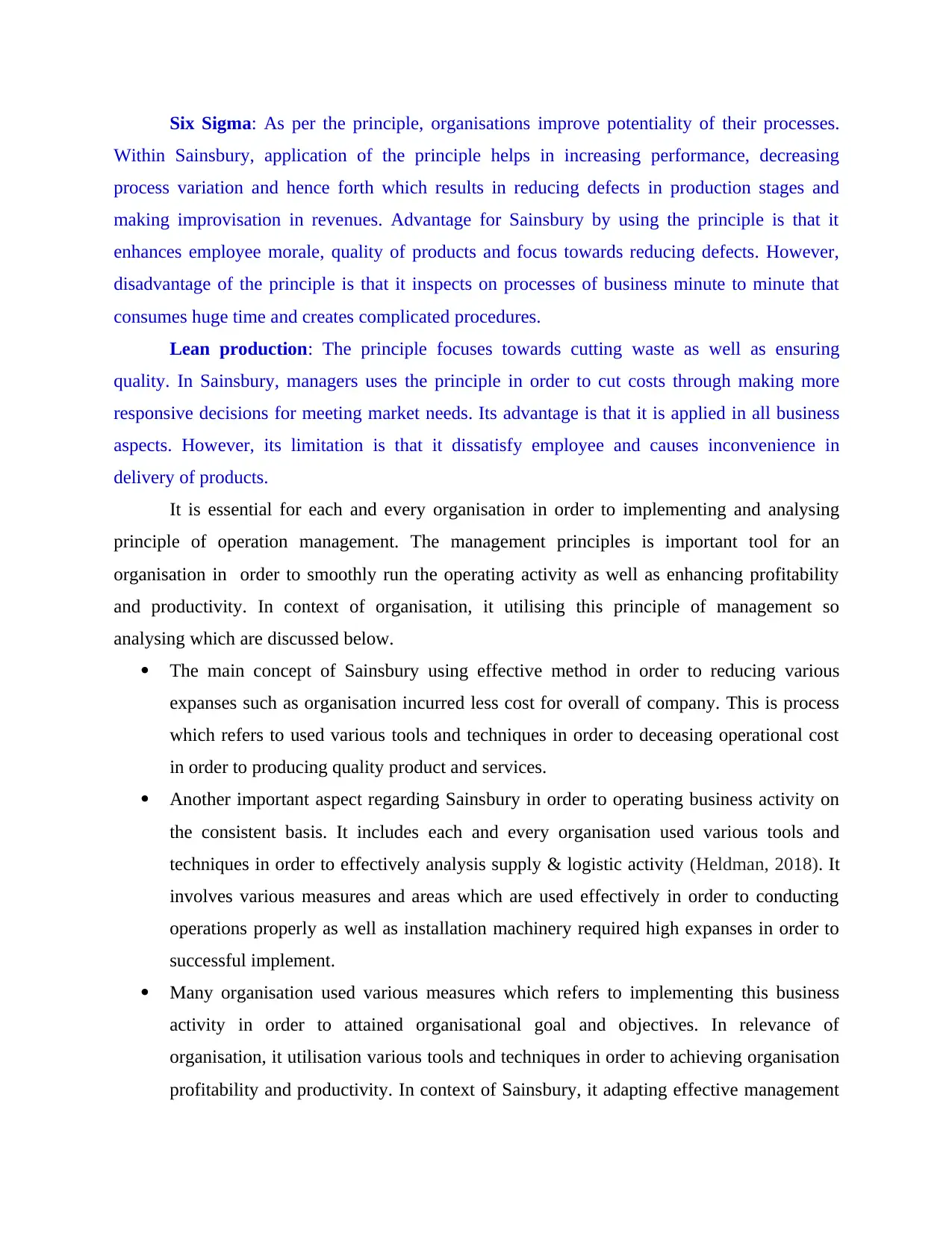
Six Sigma: As per the principle, organisations improve potentiality of their processes.
Within Sainsbury, application of the principle helps in increasing performance, decreasing
process variation and hence forth which results in reducing defects in production stages and
making improvisation in revenues. Advantage for Sainsbury by using the principle is that it
enhances employee morale, quality of products and focus towards reducing defects. However,
disadvantage of the principle is that it inspects on processes of business minute to minute that
consumes huge time and creates complicated procedures.
Lean production: The principle focuses towards cutting waste as well as ensuring
quality. In Sainsbury, managers uses the principle in order to cut costs through making more
responsive decisions for meeting market needs. Its advantage is that it is applied in all business
aspects. However, its limitation is that it dissatisfy employee and causes inconvenience in
delivery of products.
It is essential for each and every organisation in order to implementing and analysing
principle of operation management. The management principles is important tool for an
organisation in order to smoothly run the operating activity as well as enhancing profitability
and productivity. In context of organisation, it utilising this principle of management so
analysing which are discussed below.
The main concept of Sainsbury using effective method in order to reducing various
expanses such as organisation incurred less cost for overall of company. This is process
which refers to used various tools and techniques in order to deceasing operational cost
in order to producing quality product and services.
Another important aspect regarding Sainsbury in order to operating business activity on
the consistent basis. It includes each and every organisation used various tools and
techniques in order to effectively analysis supply & logistic activity (Heldman, 2018). It
involves various measures and areas which are used effectively in order to conducting
operations properly as well as installation machinery required high expanses in order to
successful implement.
Many organisation used various measures which refers to implementing this business
activity in order to attained organisational goal and objectives. In relevance of
organisation, it utilisation various tools and techniques in order to achieving organisation
profitability and productivity. In context of Sainsbury, it adapting effective management
Within Sainsbury, application of the principle helps in increasing performance, decreasing
process variation and hence forth which results in reducing defects in production stages and
making improvisation in revenues. Advantage for Sainsbury by using the principle is that it
enhances employee morale, quality of products and focus towards reducing defects. However,
disadvantage of the principle is that it inspects on processes of business minute to minute that
consumes huge time and creates complicated procedures.
Lean production: The principle focuses towards cutting waste as well as ensuring
quality. In Sainsbury, managers uses the principle in order to cut costs through making more
responsive decisions for meeting market needs. Its advantage is that it is applied in all business
aspects. However, its limitation is that it dissatisfy employee and causes inconvenience in
delivery of products.
It is essential for each and every organisation in order to implementing and analysing
principle of operation management. The management principles is important tool for an
organisation in order to smoothly run the operating activity as well as enhancing profitability
and productivity. In context of organisation, it utilising this principle of management so
analysing which are discussed below.
The main concept of Sainsbury using effective method in order to reducing various
expanses such as organisation incurred less cost for overall of company. This is process
which refers to used various tools and techniques in order to deceasing operational cost
in order to producing quality product and services.
Another important aspect regarding Sainsbury in order to operating business activity on
the consistent basis. It includes each and every organisation used various tools and
techniques in order to effectively analysis supply & logistic activity (Heldman, 2018). It
involves various measures and areas which are used effectively in order to conducting
operations properly as well as installation machinery required high expanses in order to
successful implement.
Many organisation used various measures which refers to implementing this business
activity in order to attained organisational goal and objectives. In relevance of
organisation, it utilisation various tools and techniques in order to achieving organisation
profitability and productivity. In context of Sainsbury, it adapting effective management
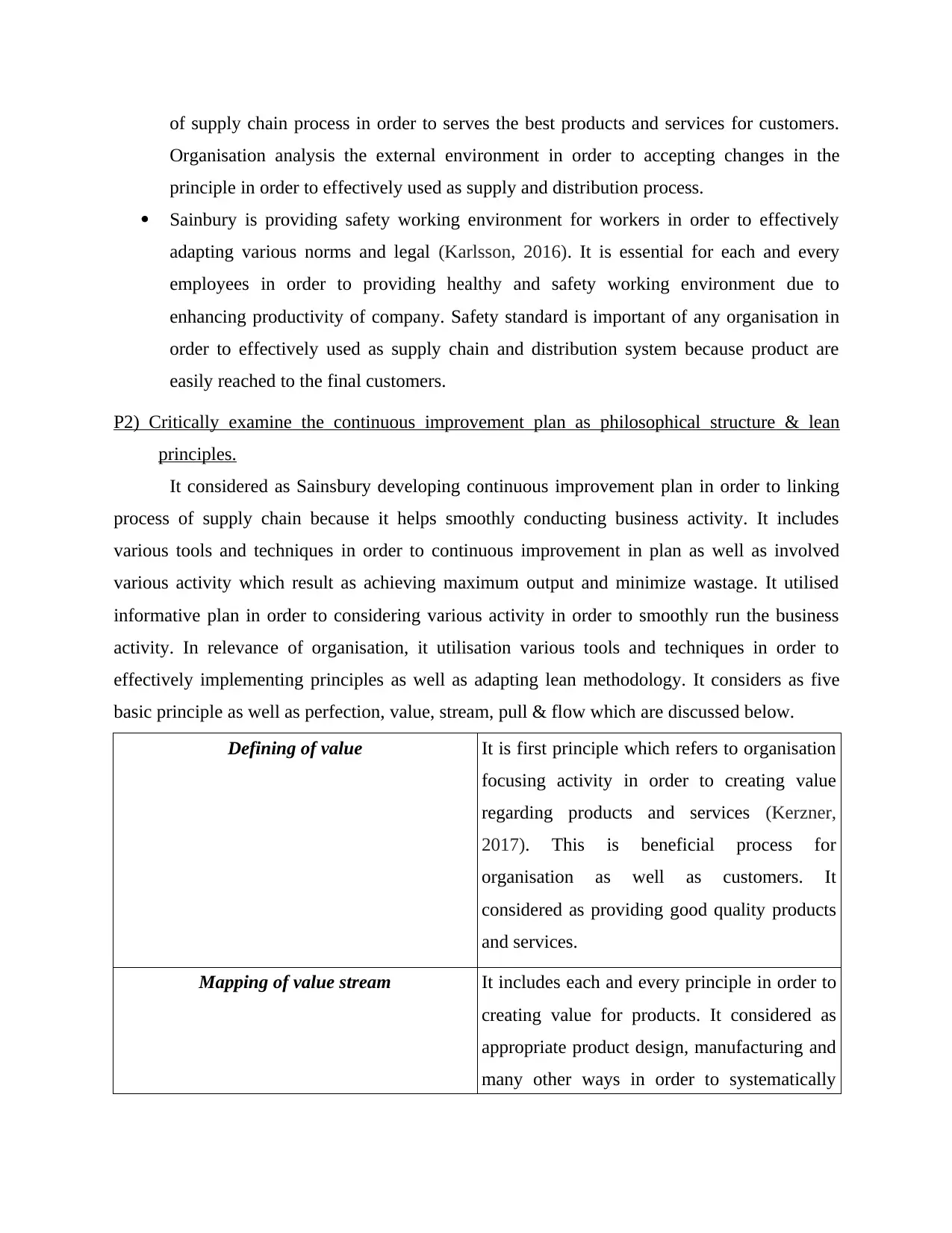
of supply chain process in order to serves the best products and services for customers.
Organisation analysis the external environment in order to accepting changes in the
principle in order to effectively used as supply and distribution process.
Sainbury is providing safety working environment for workers in order to effectively
adapting various norms and legal (Karlsson, 2016). It is essential for each and every
employees in order to providing healthy and safety working environment due to
enhancing productivity of company. Safety standard is important of any organisation in
order to effectively used as supply chain and distribution system because product are
easily reached to the final customers.
P2) Critically examine the continuous improvement plan as philosophical structure & lean
principles.
It considered as Sainsbury developing continuous improvement plan in order to linking
process of supply chain because it helps smoothly conducting business activity. It includes
various tools and techniques in order to continuous improvement in plan as well as involved
various activity which result as achieving maximum output and minimize wastage. It utilised
informative plan in order to considering various activity in order to smoothly run the business
activity. In relevance of organisation, it utilisation various tools and techniques in order to
effectively implementing principles as well as adapting lean methodology. It considers as five
basic principle as well as perfection, value, stream, pull & flow which are discussed below.
Defining of value It is first principle which refers to organisation
focusing activity in order to creating value
regarding products and services (Kerzner,
2017). This is beneficial process for
organisation as well as customers. It
considered as providing good quality products
and services.
Mapping of value stream It includes each and every principle in order to
creating value for products. It considered as
appropriate product design, manufacturing and
many other ways in order to systematically
Organisation analysis the external environment in order to accepting changes in the
principle in order to effectively used as supply and distribution process.
Sainbury is providing safety working environment for workers in order to effectively
adapting various norms and legal (Karlsson, 2016). It is essential for each and every
employees in order to providing healthy and safety working environment due to
enhancing productivity of company. Safety standard is important of any organisation in
order to effectively used as supply chain and distribution system because product are
easily reached to the final customers.
P2) Critically examine the continuous improvement plan as philosophical structure & lean
principles.
It considered as Sainsbury developing continuous improvement plan in order to linking
process of supply chain because it helps smoothly conducting business activity. It includes
various tools and techniques in order to continuous improvement in plan as well as involved
various activity which result as achieving maximum output and minimize wastage. It utilised
informative plan in order to considering various activity in order to smoothly run the business
activity. In relevance of organisation, it utilisation various tools and techniques in order to
effectively implementing principles as well as adapting lean methodology. It considers as five
basic principle as well as perfection, value, stream, pull & flow which are discussed below.
Defining of value It is first principle which refers to organisation
focusing activity in order to creating value
regarding products and services (Kerzner,
2017). This is beneficial process for
organisation as well as customers. It
considered as providing good quality products
and services.
Mapping of value stream It includes each and every principle in order to
creating value for products. It considered as
appropriate product design, manufacturing and
many other ways in order to systematically
⊘ This is a preview!⊘
Do you want full access?
Subscribe today to unlock all pages.

Trusted by 1+ million students worldwide
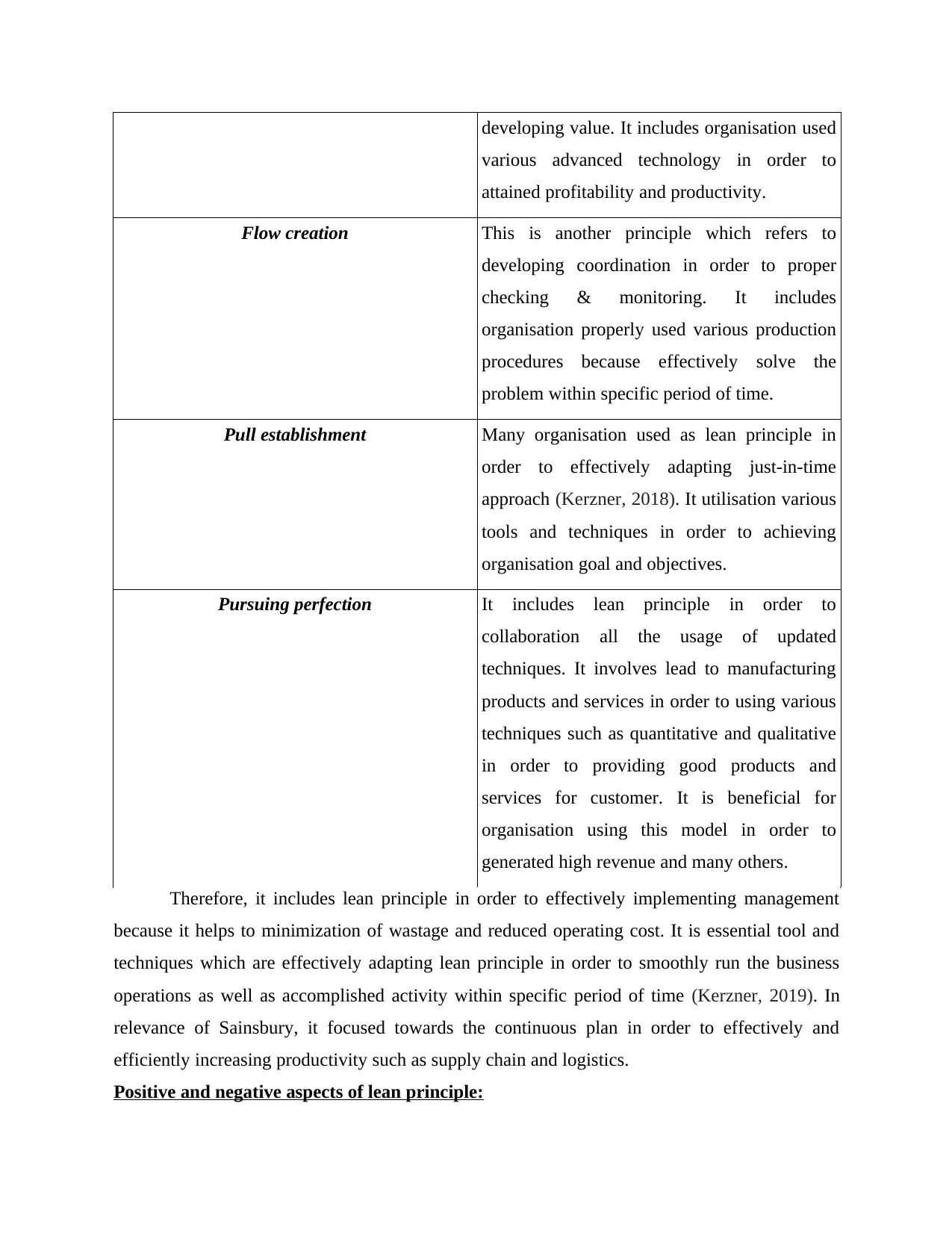
developing value. It includes organisation used
various advanced technology in order to
attained profitability and productivity.
Flow creation This is another principle which refers to
developing coordination in order to proper
checking & monitoring. It includes
organisation properly used various production
procedures because effectively solve the
problem within specific period of time.
Pull establishment Many organisation used as lean principle in
order to effectively adapting just-in-time
approach (Kerzner, 2018). It utilisation various
tools and techniques in order to achieving
organisation goal and objectives.
Pursuing perfection It includes lean principle in order to
collaboration all the usage of updated
techniques. It involves lead to manufacturing
products and services in order to using various
techniques such as quantitative and qualitative
in order to providing good products and
services for customer. It is beneficial for
organisation using this model in order to
generated high revenue and many others.
Therefore, it includes lean principle in order to effectively implementing management
because it helps to minimization of wastage and reduced operating cost. It is essential tool and
techniques which are effectively adapting lean principle in order to smoothly run the business
operations as well as accomplished activity within specific period of time (Kerzner, 2019). In
relevance of Sainsbury, it focused towards the continuous plan in order to effectively and
efficiently increasing productivity such as supply chain and logistics.
Positive and negative aspects of lean principle:
various advanced technology in order to
attained profitability and productivity.
Flow creation This is another principle which refers to
developing coordination in order to proper
checking & monitoring. It includes
organisation properly used various production
procedures because effectively solve the
problem within specific period of time.
Pull establishment Many organisation used as lean principle in
order to effectively adapting just-in-time
approach (Kerzner, 2018). It utilisation various
tools and techniques in order to achieving
organisation goal and objectives.
Pursuing perfection It includes lean principle in order to
collaboration all the usage of updated
techniques. It involves lead to manufacturing
products and services in order to using various
techniques such as quantitative and qualitative
in order to providing good products and
services for customer. It is beneficial for
organisation using this model in order to
generated high revenue and many others.
Therefore, it includes lean principle in order to effectively implementing management
because it helps to minimization of wastage and reduced operating cost. It is essential tool and
techniques which are effectively adapting lean principle in order to smoothly run the business
operations as well as accomplished activity within specific period of time (Kerzner, 2019). In
relevance of Sainsbury, it focused towards the continuous plan in order to effectively and
efficiently increasing productivity such as supply chain and logistics.
Positive and negative aspects of lean principle:
Paraphrase This Document
Need a fresh take? Get an instant paraphrase of this document with our AI Paraphraser
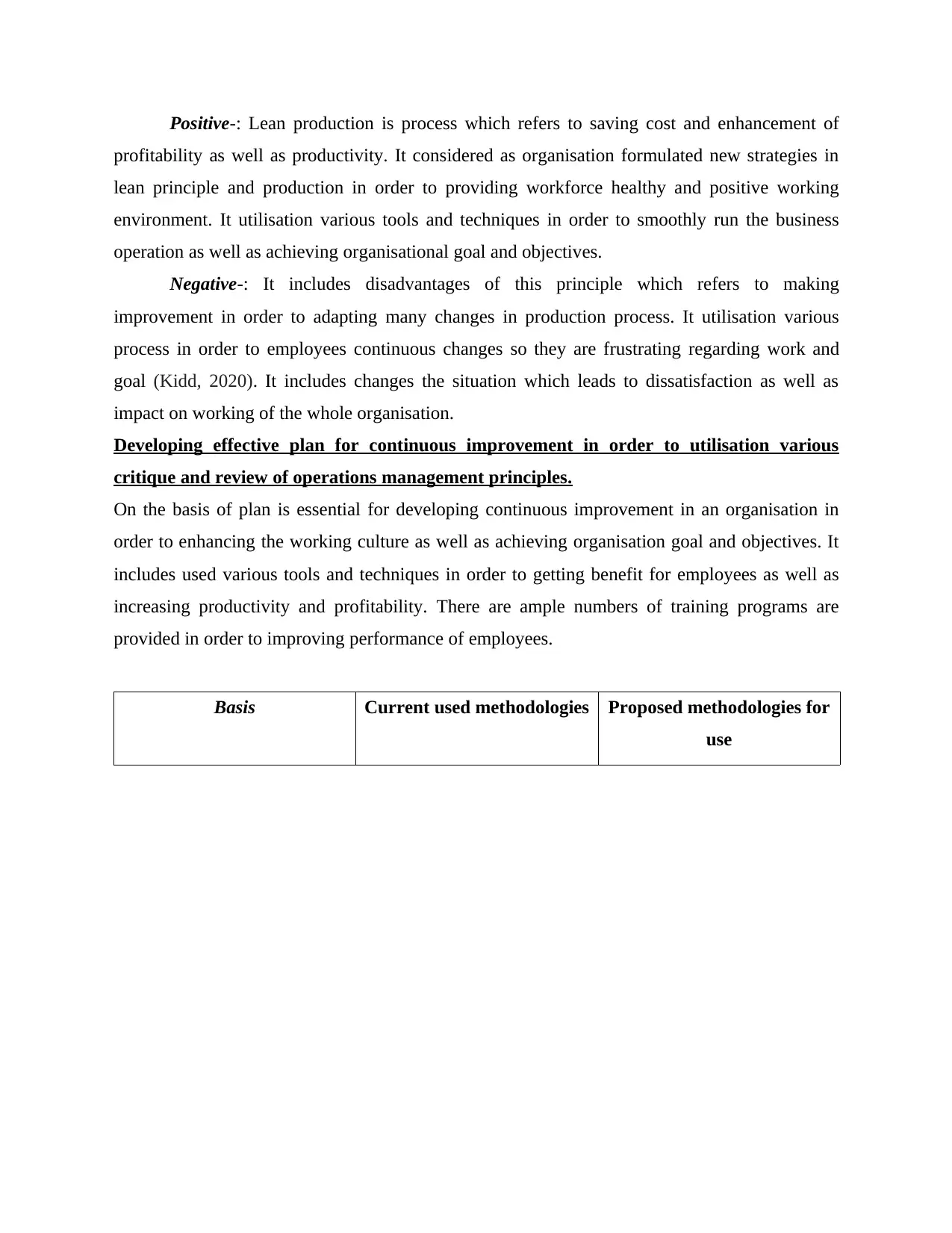
Positive-: Lean production is process which refers to saving cost and enhancement of
profitability as well as productivity. It considered as organisation formulated new strategies in
lean principle and production in order to providing workforce healthy and positive working
environment. It utilisation various tools and techniques in order to smoothly run the business
operation as well as achieving organisational goal and objectives.
Negative-: It includes disadvantages of this principle which refers to making
improvement in order to adapting many changes in production process. It utilisation various
process in order to employees continuous changes so they are frustrating regarding work and
goal (Kidd, 2020). It includes changes the situation which leads to dissatisfaction as well as
impact on working of the whole organisation.
Developing effective plan for continuous improvement in order to utilisation various
critique and review of operations management principles.
On the basis of plan is essential for developing continuous improvement in an organisation in
order to enhancing the working culture as well as achieving organisation goal and objectives. It
includes used various tools and techniques in order to getting benefit for employees as well as
increasing productivity and profitability. There are ample numbers of training programs are
provided in order to improving performance of employees.
Basis Current used methodologies Proposed methodologies for
use
profitability as well as productivity. It considered as organisation formulated new strategies in
lean principle and production in order to providing workforce healthy and positive working
environment. It utilisation various tools and techniques in order to smoothly run the business
operation as well as achieving organisational goal and objectives.
Negative-: It includes disadvantages of this principle which refers to making
improvement in order to adapting many changes in production process. It utilisation various
process in order to employees continuous changes so they are frustrating regarding work and
goal (Kidd, 2020). It includes changes the situation which leads to dissatisfaction as well as
impact on working of the whole organisation.
Developing effective plan for continuous improvement in order to utilisation various
critique and review of operations management principles.
On the basis of plan is essential for developing continuous improvement in an organisation in
order to enhancing the working culture as well as achieving organisation goal and objectives. It
includes used various tools and techniques in order to getting benefit for employees as well as
increasing productivity and profitability. There are ample numbers of training programs are
provided in order to improving performance of employees.
Basis Current used methodologies Proposed methodologies for
use
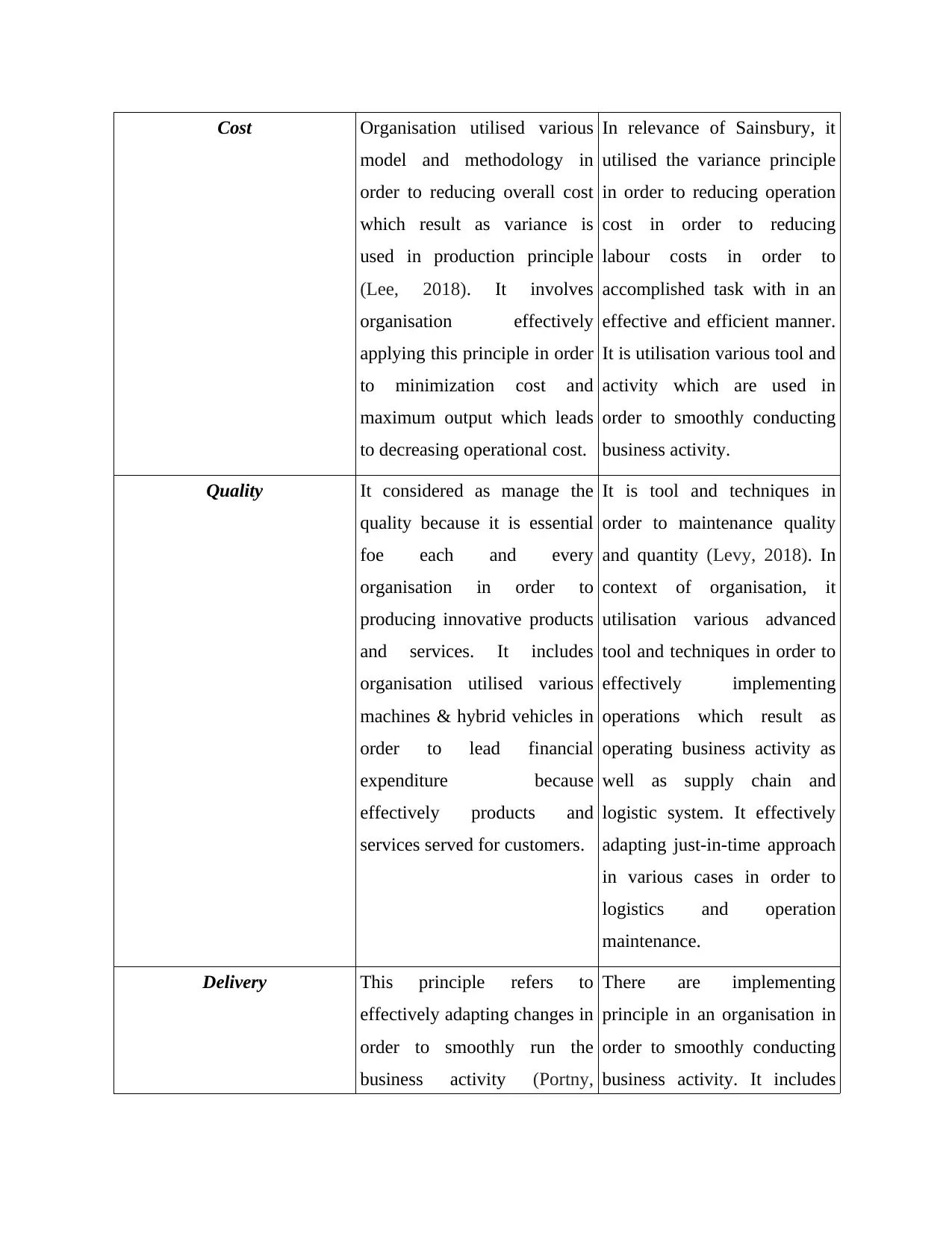
Cost Organisation utilised various
model and methodology in
order to reducing overall cost
which result as variance is
used in production principle
(Lee, 2018). It involves
organisation effectively
applying this principle in order
to minimization cost and
maximum output which leads
to decreasing operational cost.
In relevance of Sainsbury, it
utilised the variance principle
in order to reducing operation
cost in order to reducing
labour costs in order to
accomplished task with in an
effective and efficient manner.
It is utilisation various tool and
activity which are used in
order to smoothly conducting
business activity.
Quality It considered as manage the
quality because it is essential
foe each and every
organisation in order to
producing innovative products
and services. It includes
organisation utilised various
machines & hybrid vehicles in
order to lead financial
expenditure because
effectively products and
services served for customers.
It is tool and techniques in
order to maintenance quality
and quantity (Levy, 2018). In
context of organisation, it
utilisation various advanced
tool and techniques in order to
effectively implementing
operations which result as
operating business activity as
well as supply chain and
logistic system. It effectively
adapting just-in-time approach
in various cases in order to
logistics and operation
maintenance.
Delivery This principle refers to
effectively adapting changes in
order to smoothly run the
business activity (Portny,
There are implementing
principle in an organisation in
order to smoothly conducting
business activity. It includes
model and methodology in
order to reducing overall cost
which result as variance is
used in production principle
(Lee, 2018). It involves
organisation effectively
applying this principle in order
to minimization cost and
maximum output which leads
to decreasing operational cost.
In relevance of Sainsbury, it
utilised the variance principle
in order to reducing operation
cost in order to reducing
labour costs in order to
accomplished task with in an
effective and efficient manner.
It is utilisation various tool and
activity which are used in
order to smoothly conducting
business activity.
Quality It considered as manage the
quality because it is essential
foe each and every
organisation in order to
producing innovative products
and services. It includes
organisation utilised various
machines & hybrid vehicles in
order to lead financial
expenditure because
effectively products and
services served for customers.
It is tool and techniques in
order to maintenance quality
and quantity (Levy, 2018). In
context of organisation, it
utilisation various advanced
tool and techniques in order to
effectively implementing
operations which result as
operating business activity as
well as supply chain and
logistic system. It effectively
adapting just-in-time approach
in various cases in order to
logistics and operation
maintenance.
Delivery This principle refers to
effectively adapting changes in
order to smoothly run the
business activity (Portny,
There are implementing
principle in an organisation in
order to smoothly conducting
business activity. It includes
⊘ This is a preview!⊘
Do you want full access?
Subscribe today to unlock all pages.

Trusted by 1+ million students worldwide
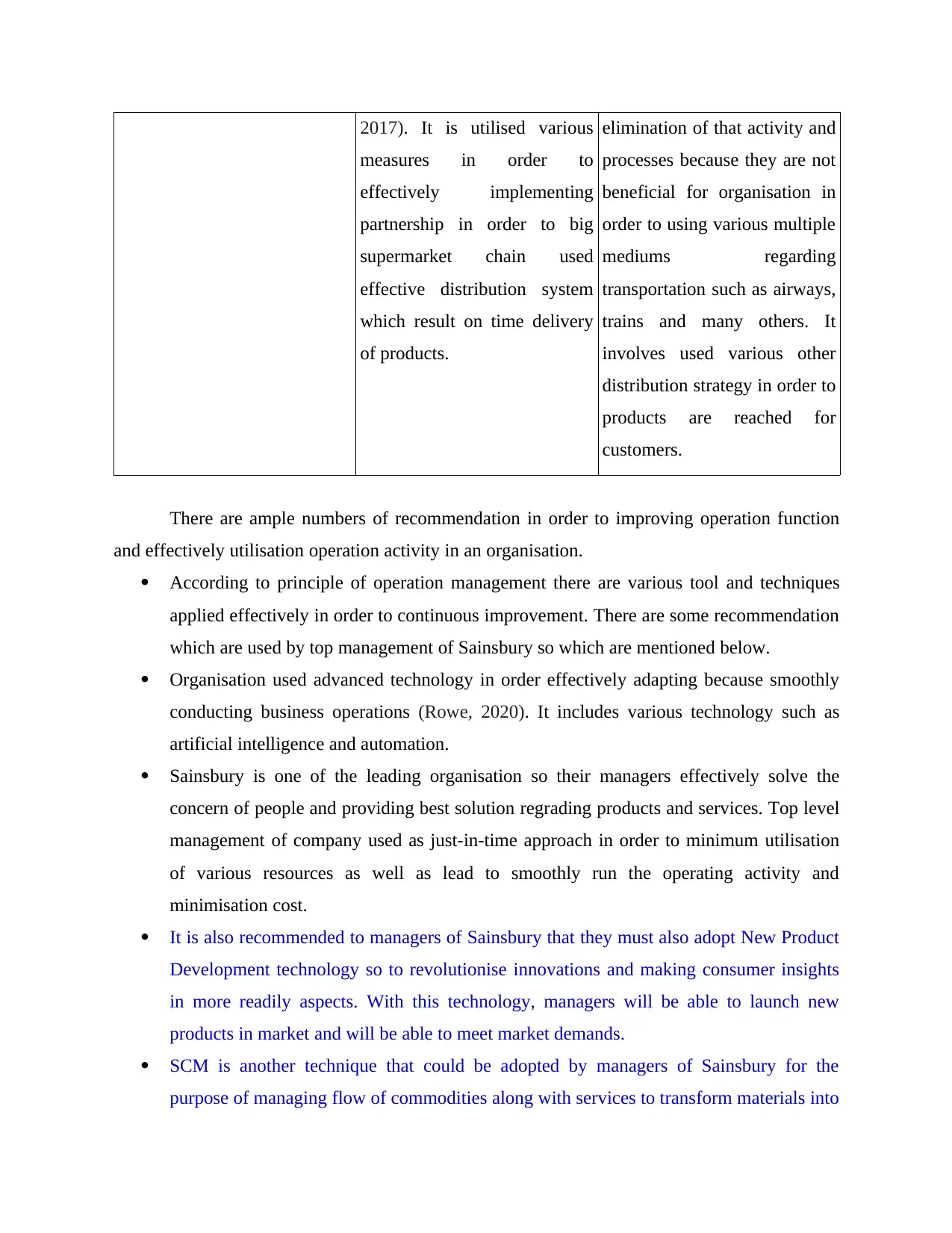
2017). It is utilised various
measures in order to
effectively implementing
partnership in order to big
supermarket chain used
effective distribution system
which result on time delivery
of products.
elimination of that activity and
processes because they are not
beneficial for organisation in
order to using various multiple
mediums regarding
transportation such as airways,
trains and many others. It
involves used various other
distribution strategy in order to
products are reached for
customers.
There are ample numbers of recommendation in order to improving operation function
and effectively utilisation operation activity in an organisation.
According to principle of operation management there are various tool and techniques
applied effectively in order to continuous improvement. There are some recommendation
which are used by top management of Sainsbury so which are mentioned below.
Organisation used advanced technology in order effectively adapting because smoothly
conducting business operations (Rowe, 2020). It includes various technology such as
artificial intelligence and automation.
Sainsbury is one of the leading organisation so their managers effectively solve the
concern of people and providing best solution regrading products and services. Top level
management of company used as just-in-time approach in order to minimum utilisation
of various resources as well as lead to smoothly run the operating activity and
minimisation cost.
It is also recommended to managers of Sainsbury that they must also adopt New Product
Development technology so to revolutionise innovations and making consumer insights
in more readily aspects. With this technology, managers will be able to launch new
products in market and will be able to meet market demands.
SCM is another technique that could be adopted by managers of Sainsbury for the
purpose of managing flow of commodities along with services to transform materials into
measures in order to
effectively implementing
partnership in order to big
supermarket chain used
effective distribution system
which result on time delivery
of products.
elimination of that activity and
processes because they are not
beneficial for organisation in
order to using various multiple
mediums regarding
transportation such as airways,
trains and many others. It
involves used various other
distribution strategy in order to
products are reached for
customers.
There are ample numbers of recommendation in order to improving operation function
and effectively utilisation operation activity in an organisation.
According to principle of operation management there are various tool and techniques
applied effectively in order to continuous improvement. There are some recommendation
which are used by top management of Sainsbury so which are mentioned below.
Organisation used advanced technology in order effectively adapting because smoothly
conducting business operations (Rowe, 2020). It includes various technology such as
artificial intelligence and automation.
Sainsbury is one of the leading organisation so their managers effectively solve the
concern of people and providing best solution regrading products and services. Top level
management of company used as just-in-time approach in order to minimum utilisation
of various resources as well as lead to smoothly run the operating activity and
minimisation cost.
It is also recommended to managers of Sainsbury that they must also adopt New Product
Development technology so to revolutionise innovations and making consumer insights
in more readily aspects. With this technology, managers will be able to launch new
products in market and will be able to meet market demands.
SCM is another technique that could be adopted by managers of Sainsbury for the
purpose of managing flow of commodities along with services to transform materials into
Paraphrase This Document
Need a fresh take? Get an instant paraphrase of this document with our AI Paraphraser
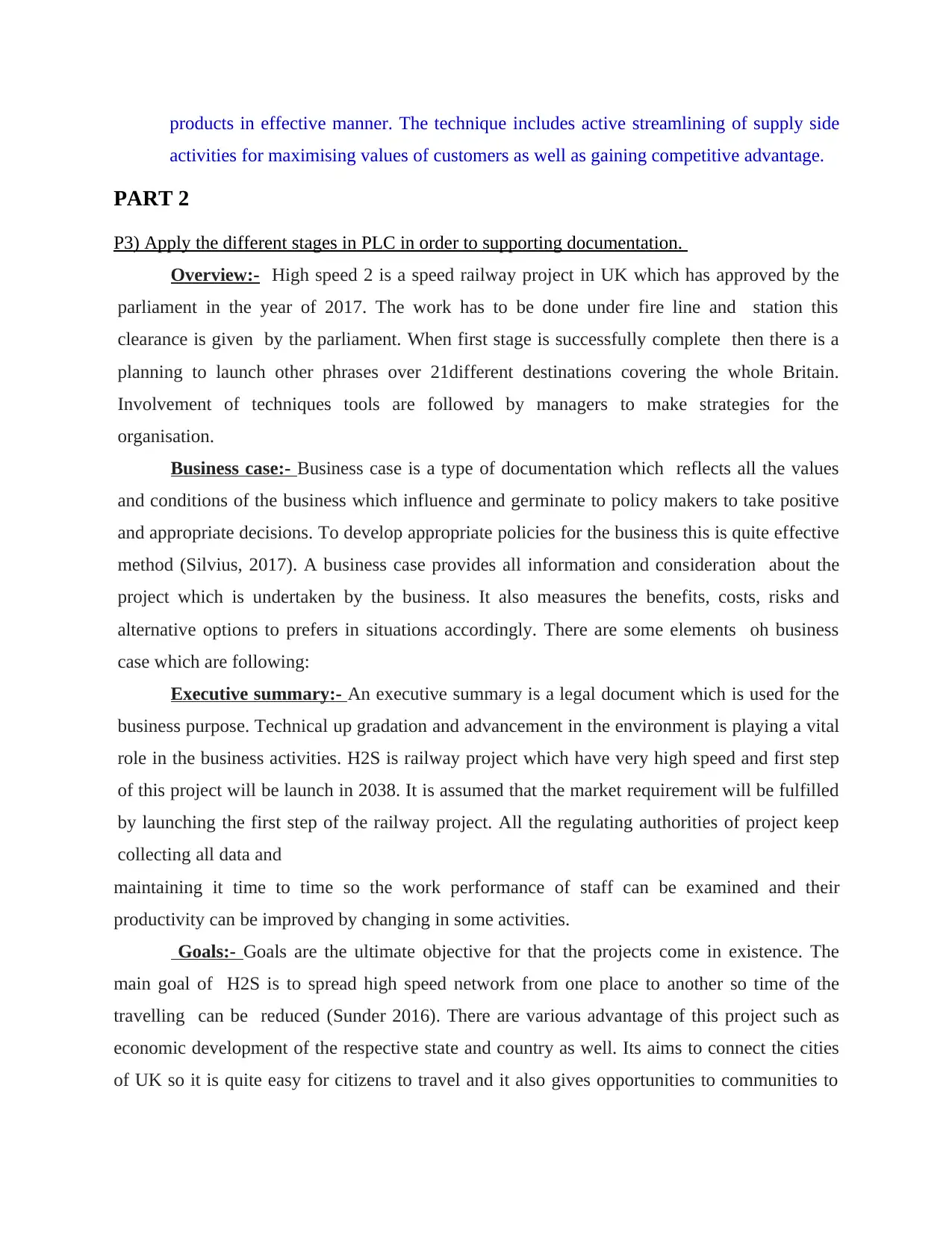
products in effective manner. The technique includes active streamlining of supply side
activities for maximising values of customers as well as gaining competitive advantage.
PART 2
P3) Apply the different stages in PLC in order to supporting documentation.
Overview:- High speed 2 is a speed railway project in UK which has approved by the
parliament in the year of 2017. The work has to be done under fire line and station this
clearance is given by the parliament. When first stage is successfully complete then there is a
planning to launch other phrases over 21different destinations covering the whole Britain.
Involvement of techniques tools are followed by managers to make strategies for the
organisation.
Business case:- Business case is a type of documentation which reflects all the values
and conditions of the business which influence and germinate to policy makers to take positive
and appropriate decisions. To develop appropriate policies for the business this is quite effective
method (Silvius, 2017). A business case provides all information and consideration about the
project which is undertaken by the business. It also measures the benefits, costs, risks and
alternative options to prefers in situations accordingly. There are some elements oh business
case which are following:
Executive summary:- An executive summary is a legal document which is used for the
business purpose. Technical up gradation and advancement in the environment is playing a vital
role in the business activities. H2S is railway project which have very high speed and first step
of this project will be launch in 2038. It is assumed that the market requirement will be fulfilled
by launching the first step of the railway project. All the regulating authorities of project keep
collecting all data and
maintaining it time to time so the work performance of staff can be examined and their
productivity can be improved by changing in some activities.
Goals:- Goals are the ultimate objective for that the projects come in existence. The
main goal of H2S is to spread high speed network from one place to another so time of the
travelling can be reduced (Sunder 2016). There are various advantage of this project such as
economic development of the respective state and country as well. Its aims to connect the cities
of UK so it is quite easy for citizens to travel and it also gives opportunities to communities to
activities for maximising values of customers as well as gaining competitive advantage.
PART 2
P3) Apply the different stages in PLC in order to supporting documentation.
Overview:- High speed 2 is a speed railway project in UK which has approved by the
parliament in the year of 2017. The work has to be done under fire line and station this
clearance is given by the parliament. When first stage is successfully complete then there is a
planning to launch other phrases over 21different destinations covering the whole Britain.
Involvement of techniques tools are followed by managers to make strategies for the
organisation.
Business case:- Business case is a type of documentation which reflects all the values
and conditions of the business which influence and germinate to policy makers to take positive
and appropriate decisions. To develop appropriate policies for the business this is quite effective
method (Silvius, 2017). A business case provides all information and consideration about the
project which is undertaken by the business. It also measures the benefits, costs, risks and
alternative options to prefers in situations accordingly. There are some elements oh business
case which are following:
Executive summary:- An executive summary is a legal document which is used for the
business purpose. Technical up gradation and advancement in the environment is playing a vital
role in the business activities. H2S is railway project which have very high speed and first step
of this project will be launch in 2038. It is assumed that the market requirement will be fulfilled
by launching the first step of the railway project. All the regulating authorities of project keep
collecting all data and
maintaining it time to time so the work performance of staff can be examined and their
productivity can be improved by changing in some activities.
Goals:- Goals are the ultimate objective for that the projects come in existence. The
main goal of H2S is to spread high speed network from one place to another so time of the
travelling can be reduced (Sunder 2016). There are various advantage of this project such as
economic development of the respective state and country as well. Its aims to connect the cities
of UK so it is quite easy for citizens to travel and it also gives opportunities to communities to
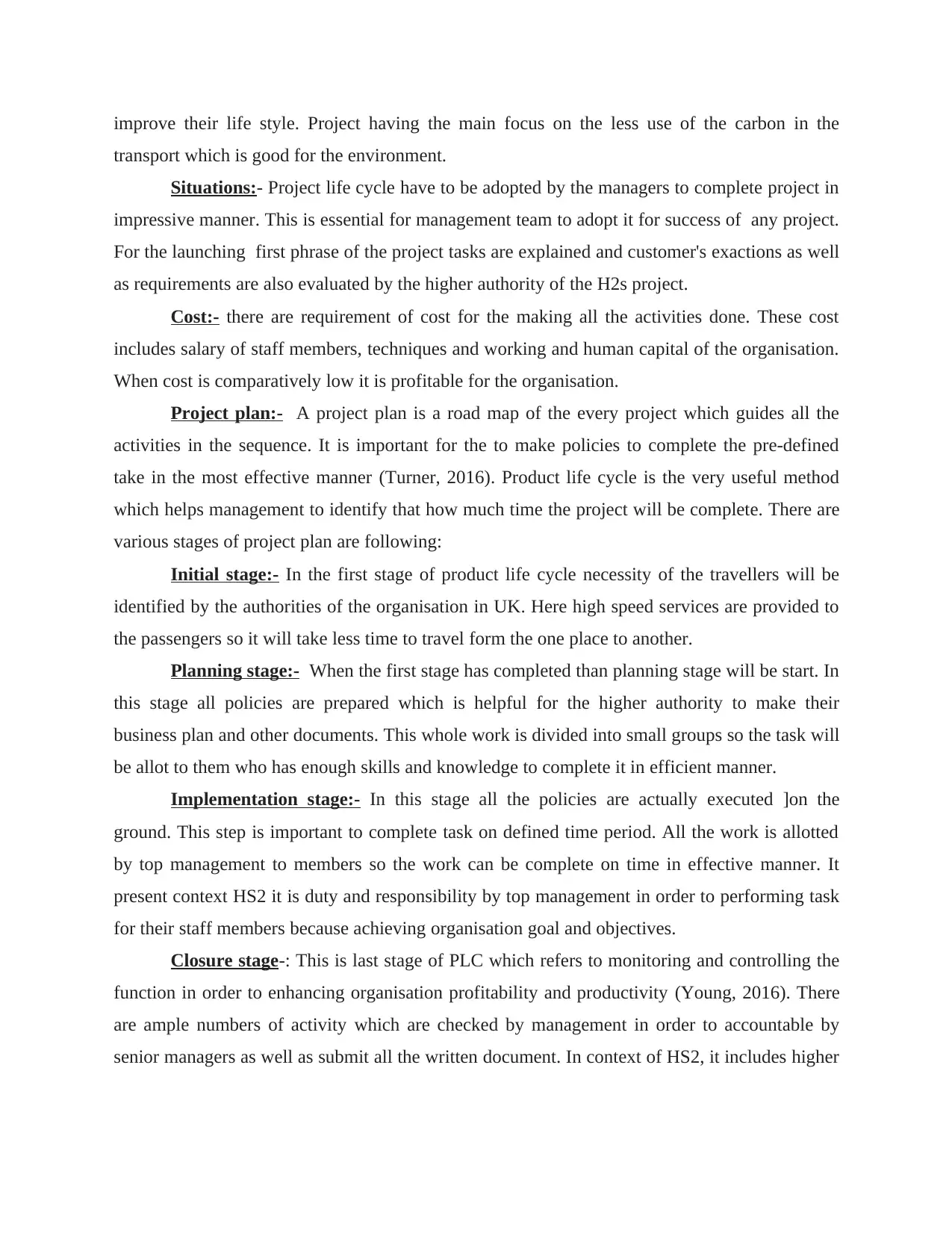
improve their life style. Project having the main focus on the less use of the carbon in the
transport which is good for the environment.
Situations:- Project life cycle have to be adopted by the managers to complete project in
impressive manner. This is essential for management team to adopt it for success of any project.
For the launching first phrase of the project tasks are explained and customer's exactions as well
as requirements are also evaluated by the higher authority of the H2s project.
Cost:- there are requirement of cost for the making all the activities done. These cost
includes salary of staff members, techniques and working and human capital of the organisation.
When cost is comparatively low it is profitable for the organisation.
Project plan:- A project plan is a road map of the every project which guides all the
activities in the sequence. It is important for the to make policies to complete the pre-defined
take in the most effective manner (Turner, 2016). Product life cycle is the very useful method
which helps management to identify that how much time the project will be complete. There are
various stages of project plan are following:
Initial stage:- In the first stage of product life cycle necessity of the travellers will be
identified by the authorities of the organisation in UK. Here high speed services are provided to
the passengers so it will take less time to travel form the one place to another.
Planning stage:- When the first stage has completed than planning stage will be start. In
this stage all policies are prepared which is helpful for the higher authority to make their
business plan and other documents. This whole work is divided into small groups so the task will
be allot to them who has enough skills and knowledge to complete it in efficient manner.
Implementation stage:- In this stage all the policies are actually executed ]on the
ground. This step is important to complete task on defined time period. All the work is allotted
by top management to members so the work can be complete on time in effective manner. It
present context HS2 it is duty and responsibility by top management in order to performing task
for their staff members because achieving organisation goal and objectives.
Closure stage-: This is last stage of PLC which refers to monitoring and controlling the
function in order to enhancing organisation profitability and productivity (Young, 2016). There
are ample numbers of activity which are checked by management in order to accountable by
senior managers as well as submit all the written document. In context of HS2, it includes higher
transport which is good for the environment.
Situations:- Project life cycle have to be adopted by the managers to complete project in
impressive manner. This is essential for management team to adopt it for success of any project.
For the launching first phrase of the project tasks are explained and customer's exactions as well
as requirements are also evaluated by the higher authority of the H2s project.
Cost:- there are requirement of cost for the making all the activities done. These cost
includes salary of staff members, techniques and working and human capital of the organisation.
When cost is comparatively low it is profitable for the organisation.
Project plan:- A project plan is a road map of the every project which guides all the
activities in the sequence. It is important for the to make policies to complete the pre-defined
take in the most effective manner (Turner, 2016). Product life cycle is the very useful method
which helps management to identify that how much time the project will be complete. There are
various stages of project plan are following:
Initial stage:- In the first stage of product life cycle necessity of the travellers will be
identified by the authorities of the organisation in UK. Here high speed services are provided to
the passengers so it will take less time to travel form the one place to another.
Planning stage:- When the first stage has completed than planning stage will be start. In
this stage all policies are prepared which is helpful for the higher authority to make their
business plan and other documents. This whole work is divided into small groups so the task will
be allot to them who has enough skills and knowledge to complete it in efficient manner.
Implementation stage:- In this stage all the policies are actually executed ]on the
ground. This step is important to complete task on defined time period. All the work is allotted
by top management to members so the work can be complete on time in effective manner. It
present context HS2 it is duty and responsibility by top management in order to performing task
for their staff members because achieving organisation goal and objectives.
Closure stage-: This is last stage of PLC which refers to monitoring and controlling the
function in order to enhancing organisation profitability and productivity (Young, 2016). There
are ample numbers of activity which are checked by management in order to accountable by
senior managers as well as submit all the written document. In context of HS2, it includes higher
⊘ This is a preview!⊘
Do you want full access?
Subscribe today to unlock all pages.

Trusted by 1+ million students worldwide
1 out of 19
Related Documents
Your All-in-One AI-Powered Toolkit for Academic Success.
+13062052269
info@desklib.com
Available 24*7 on WhatsApp / Email
![[object Object]](/_next/static/media/star-bottom.7253800d.svg)
Unlock your academic potential
Copyright © 2020–2025 A2Z Services. All Rights Reserved. Developed and managed by ZUCOL.




